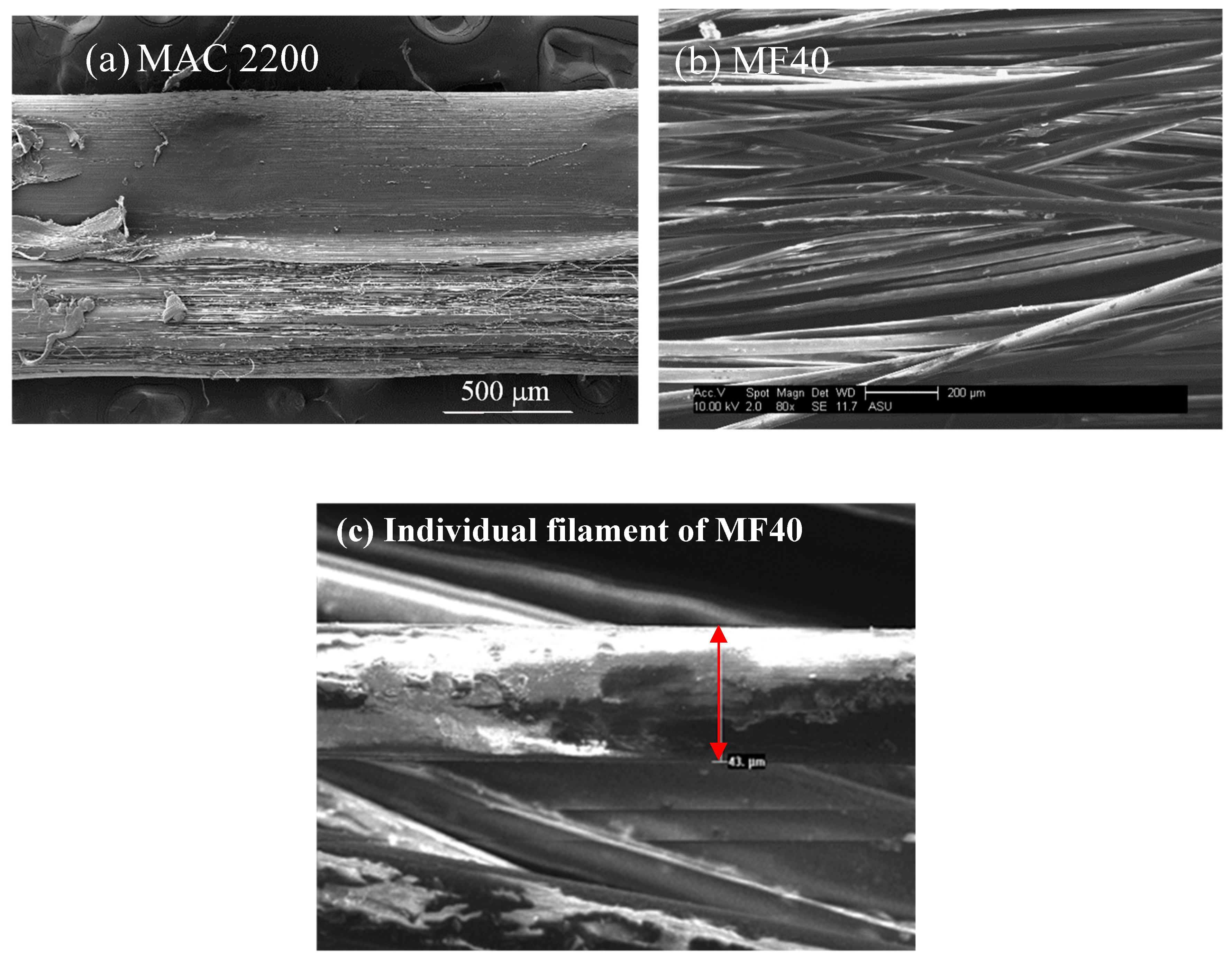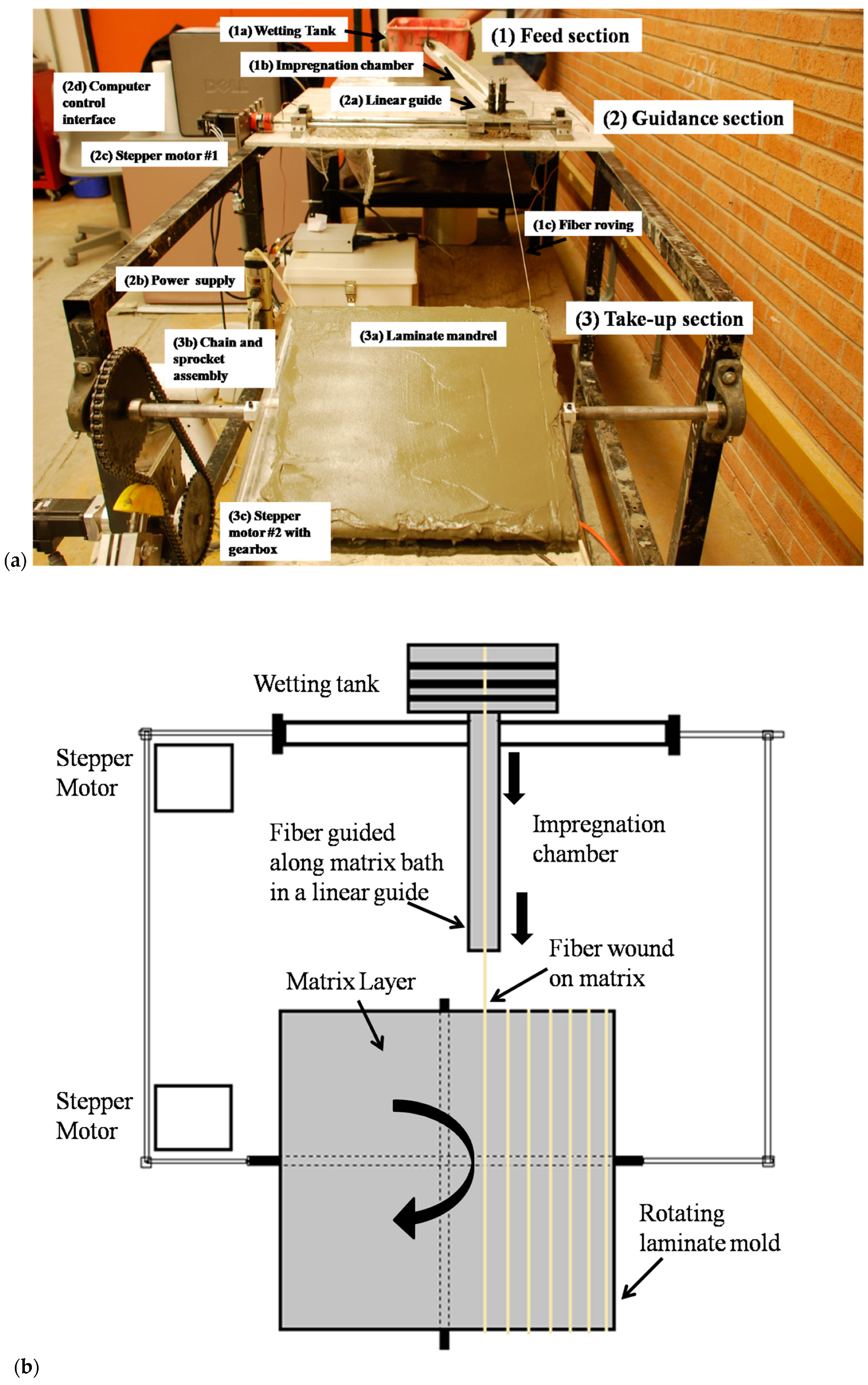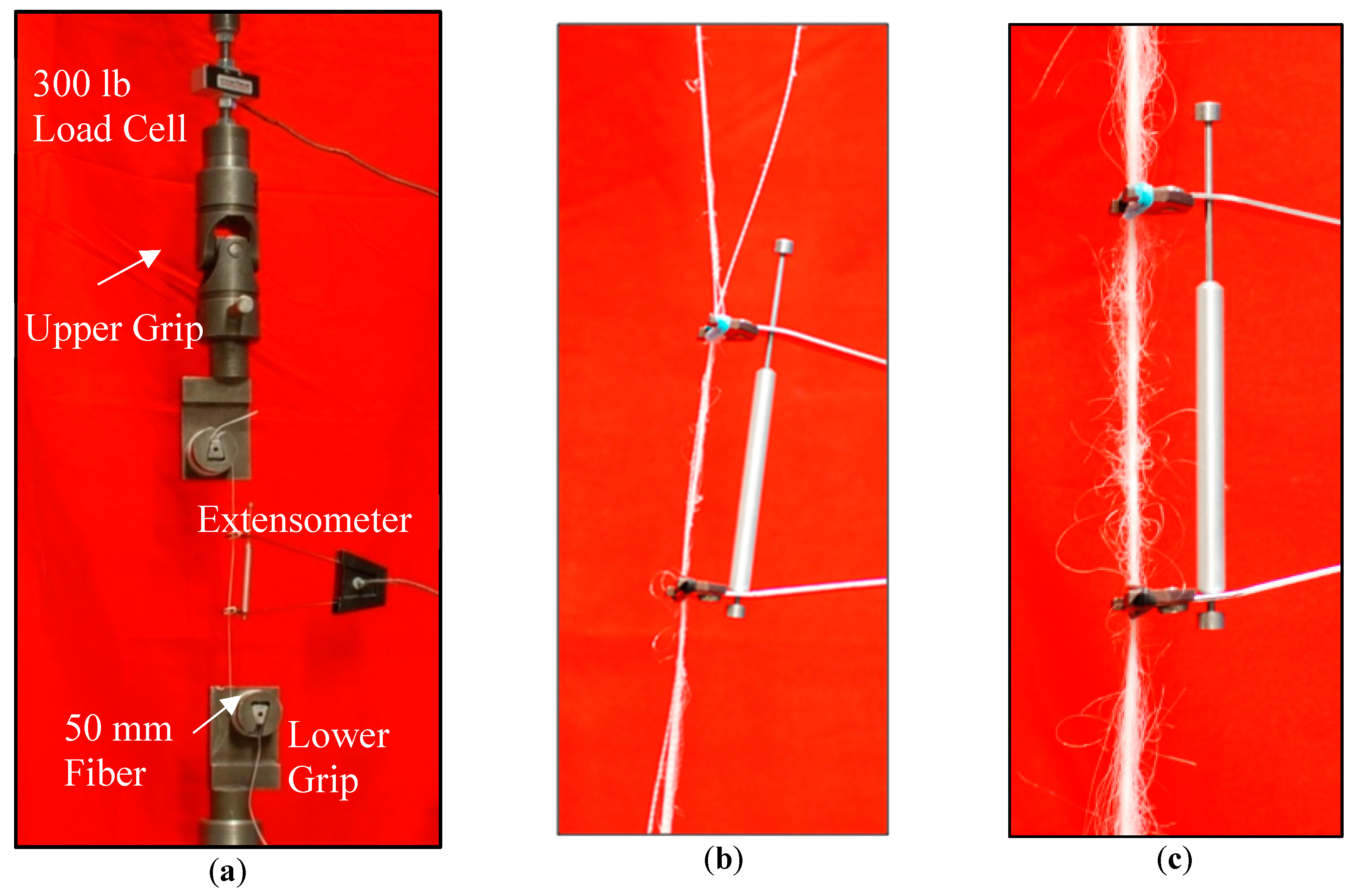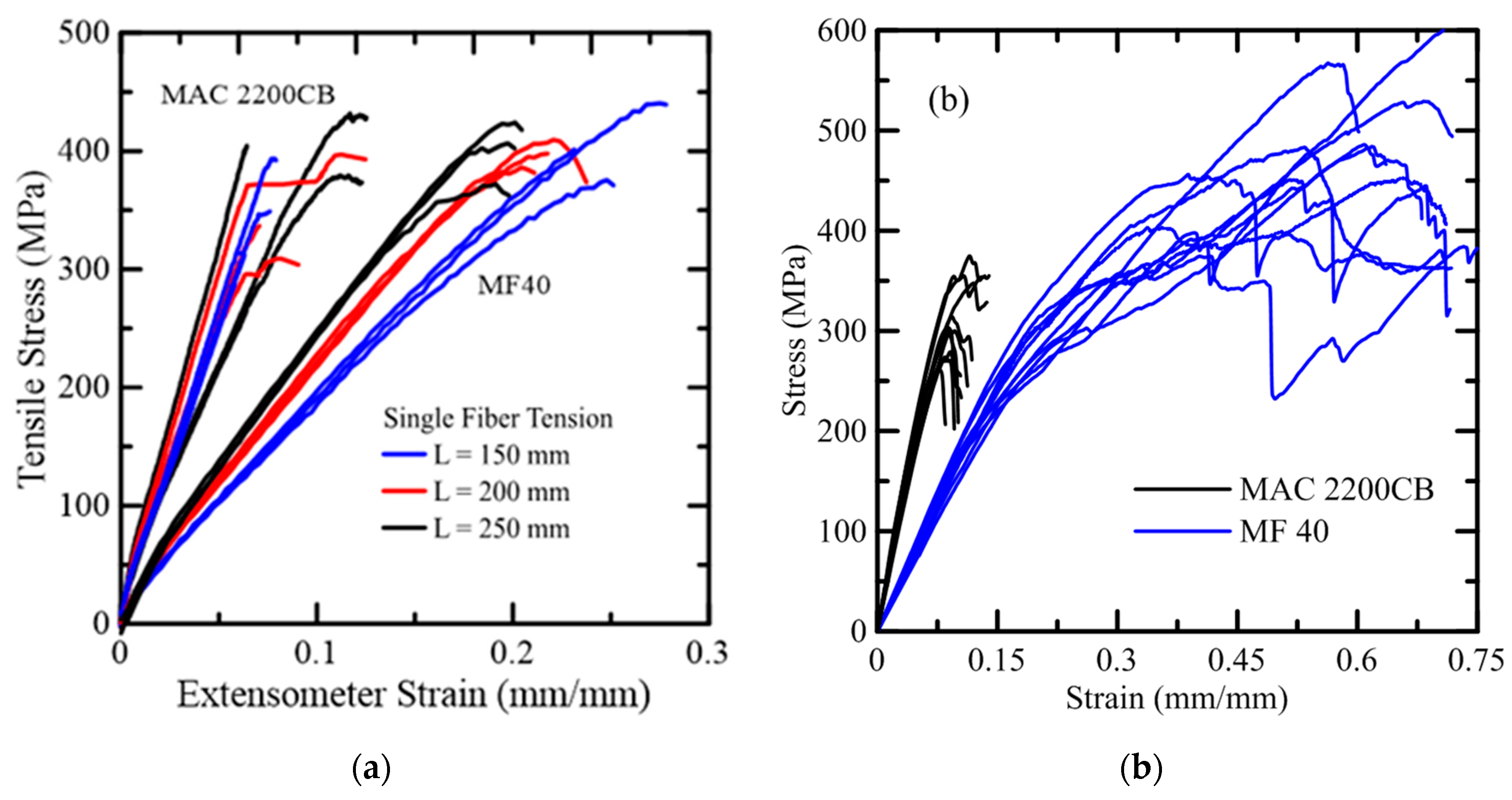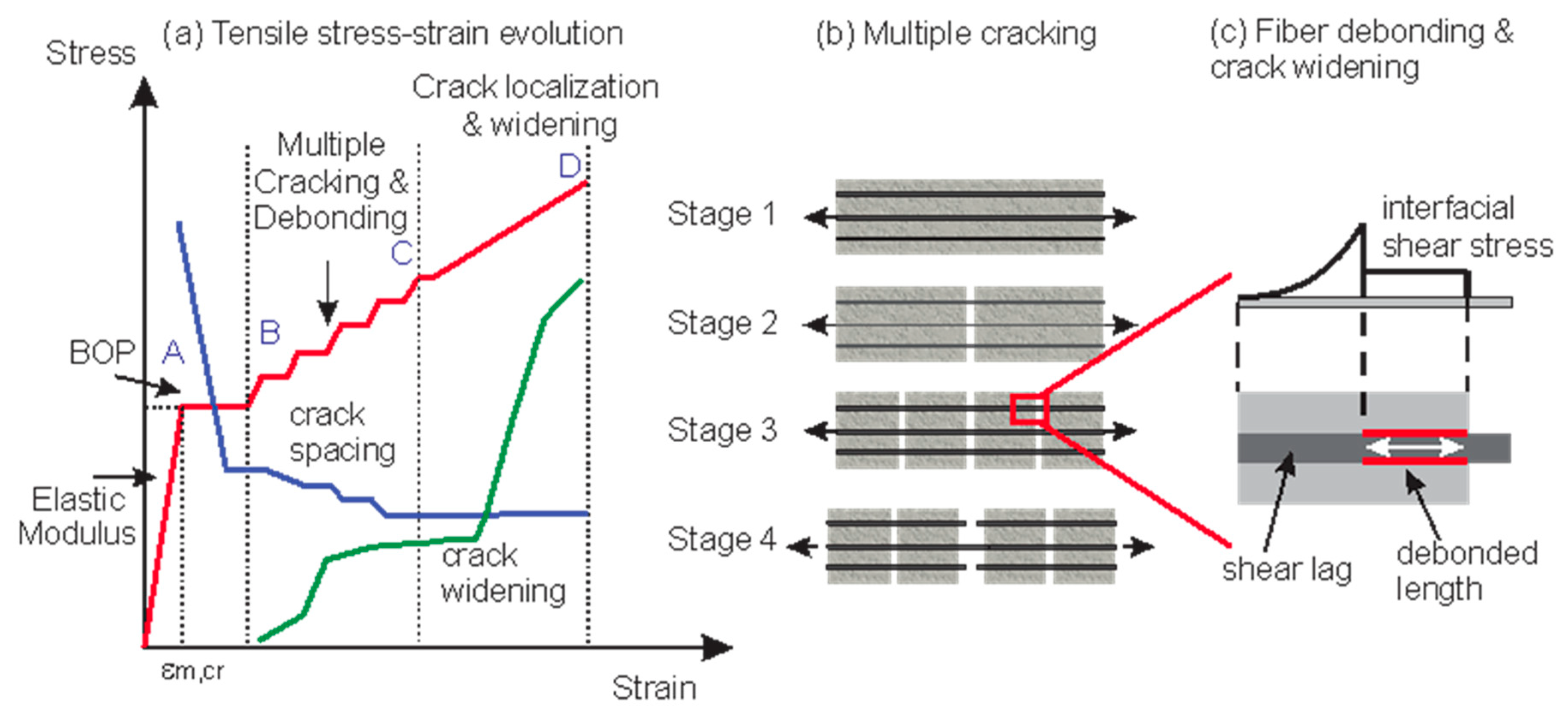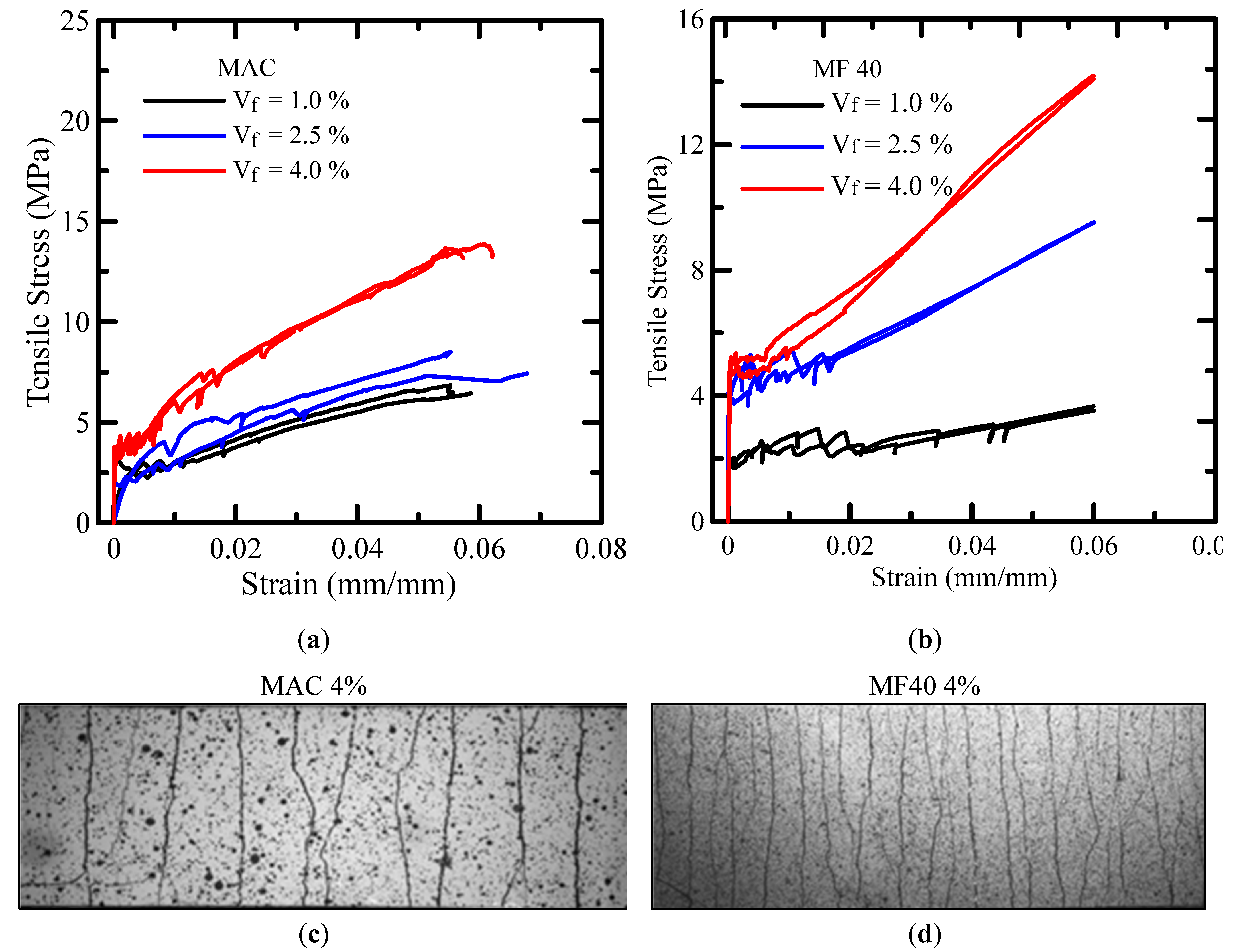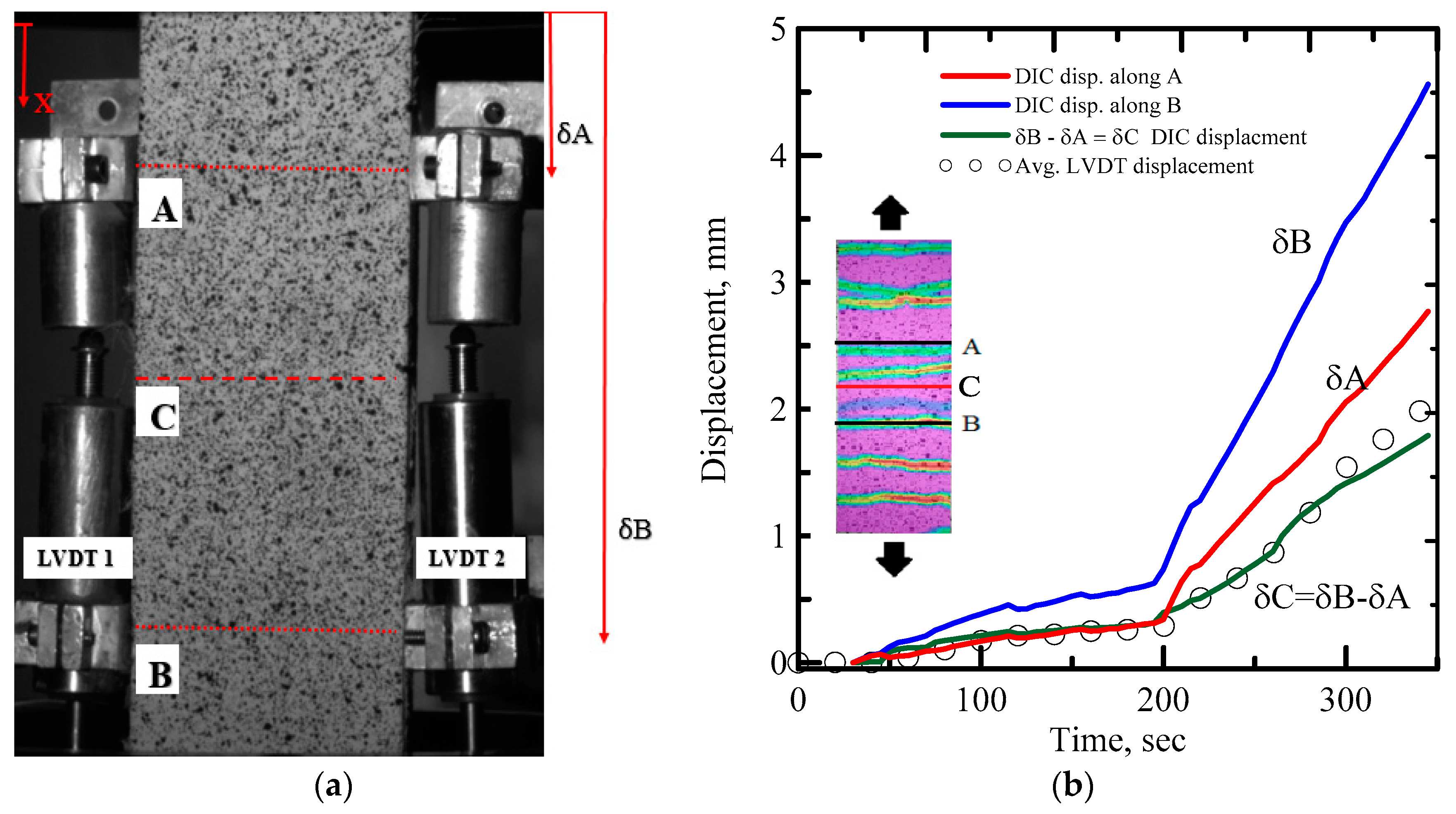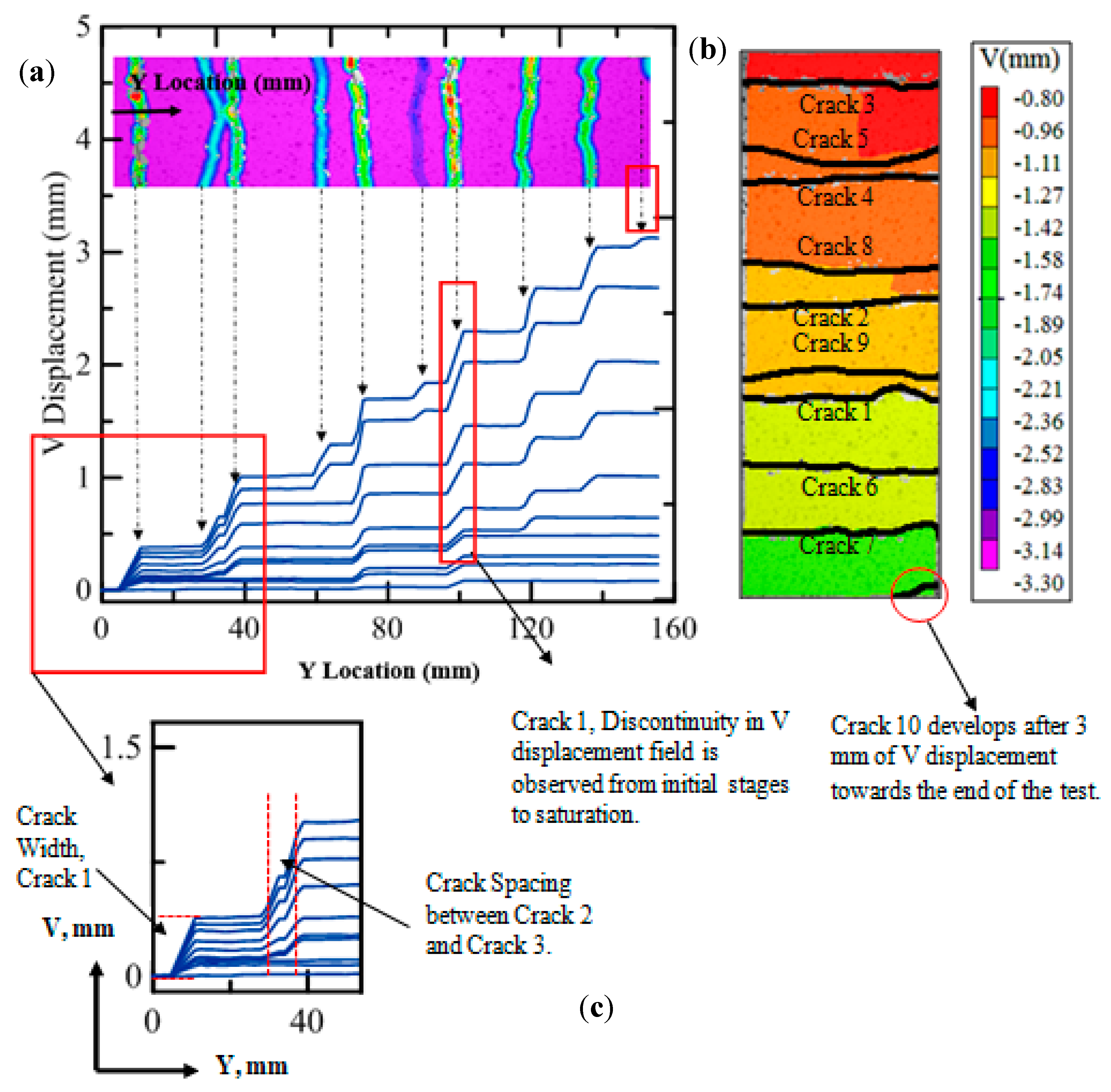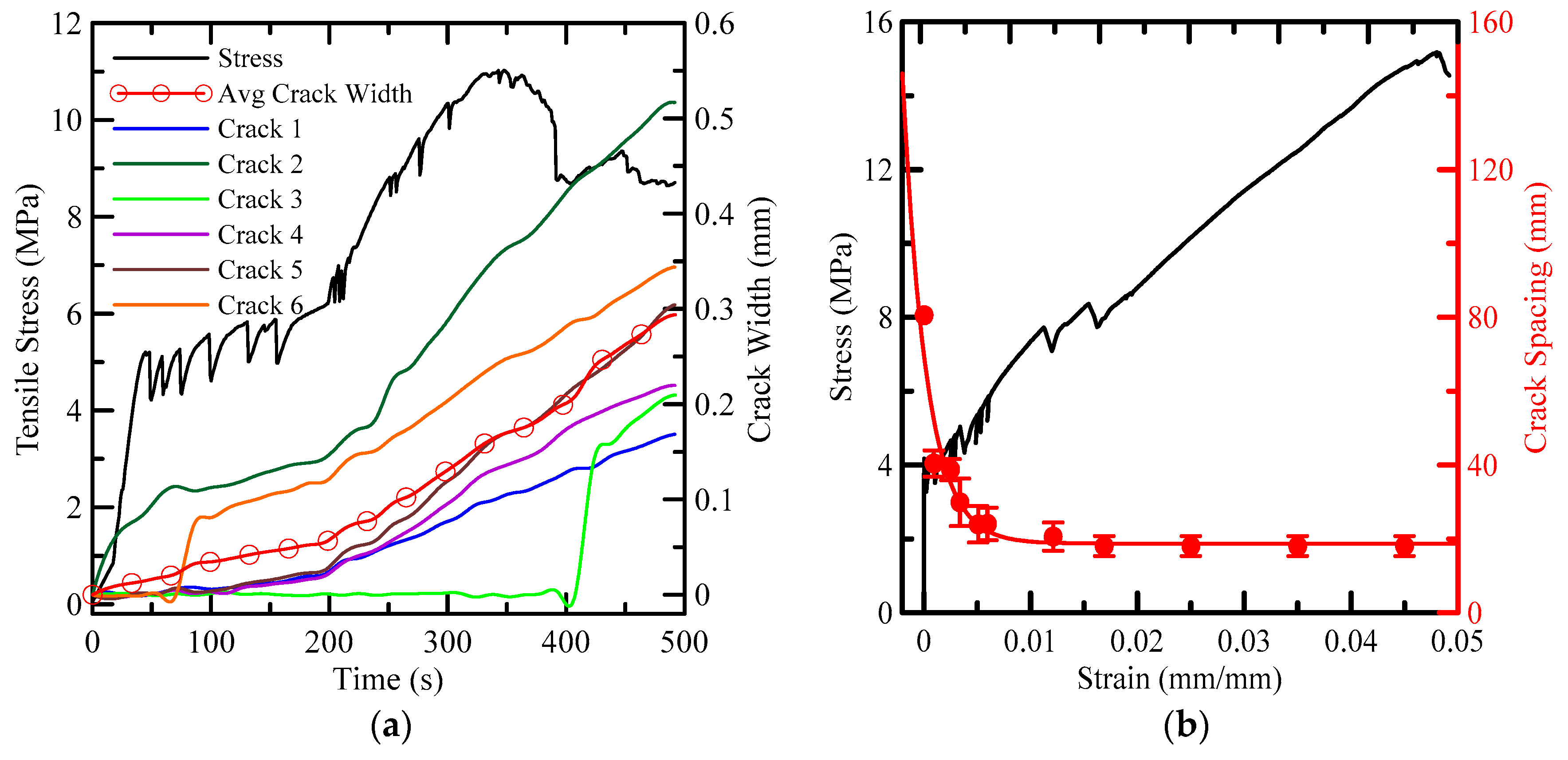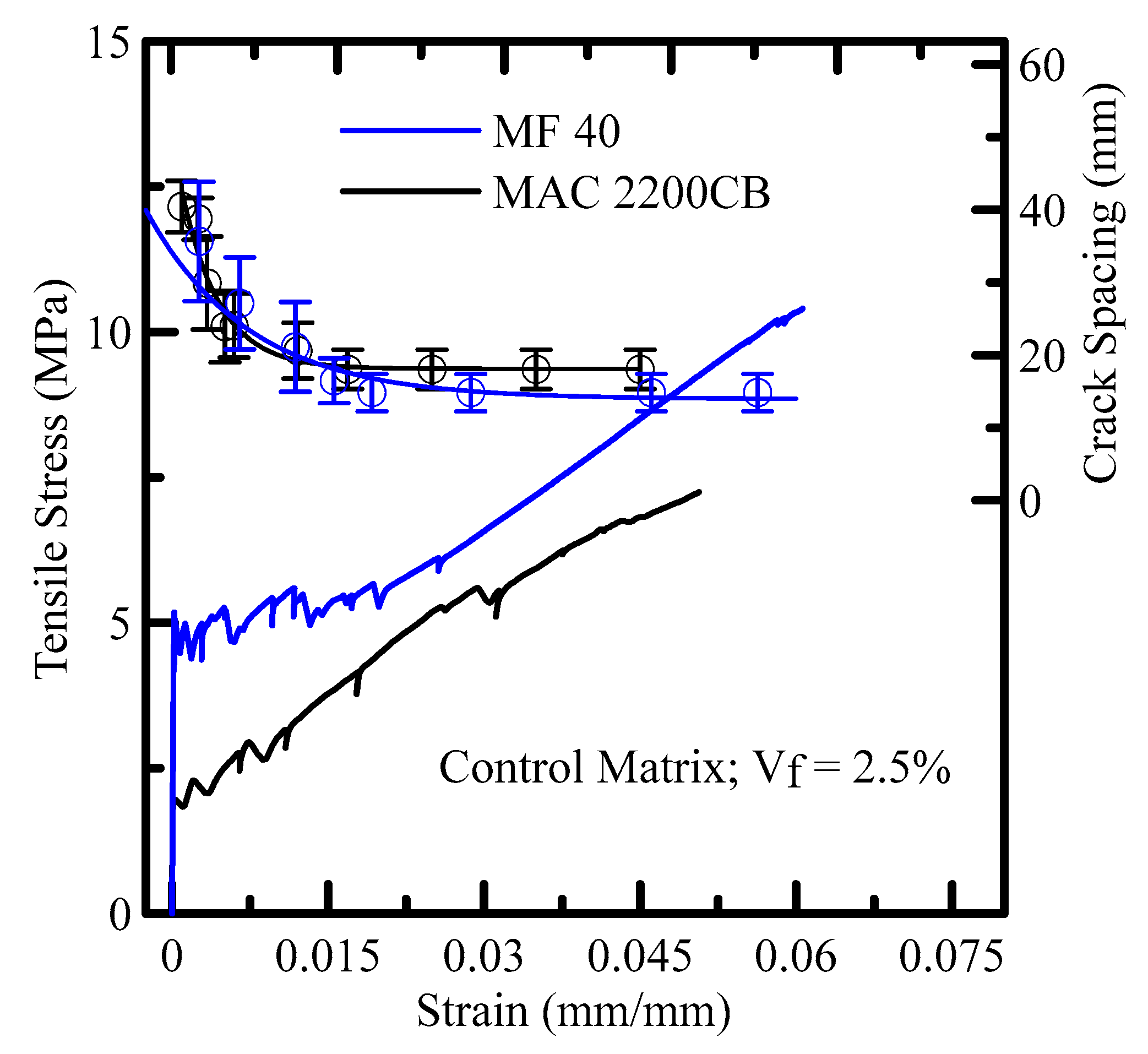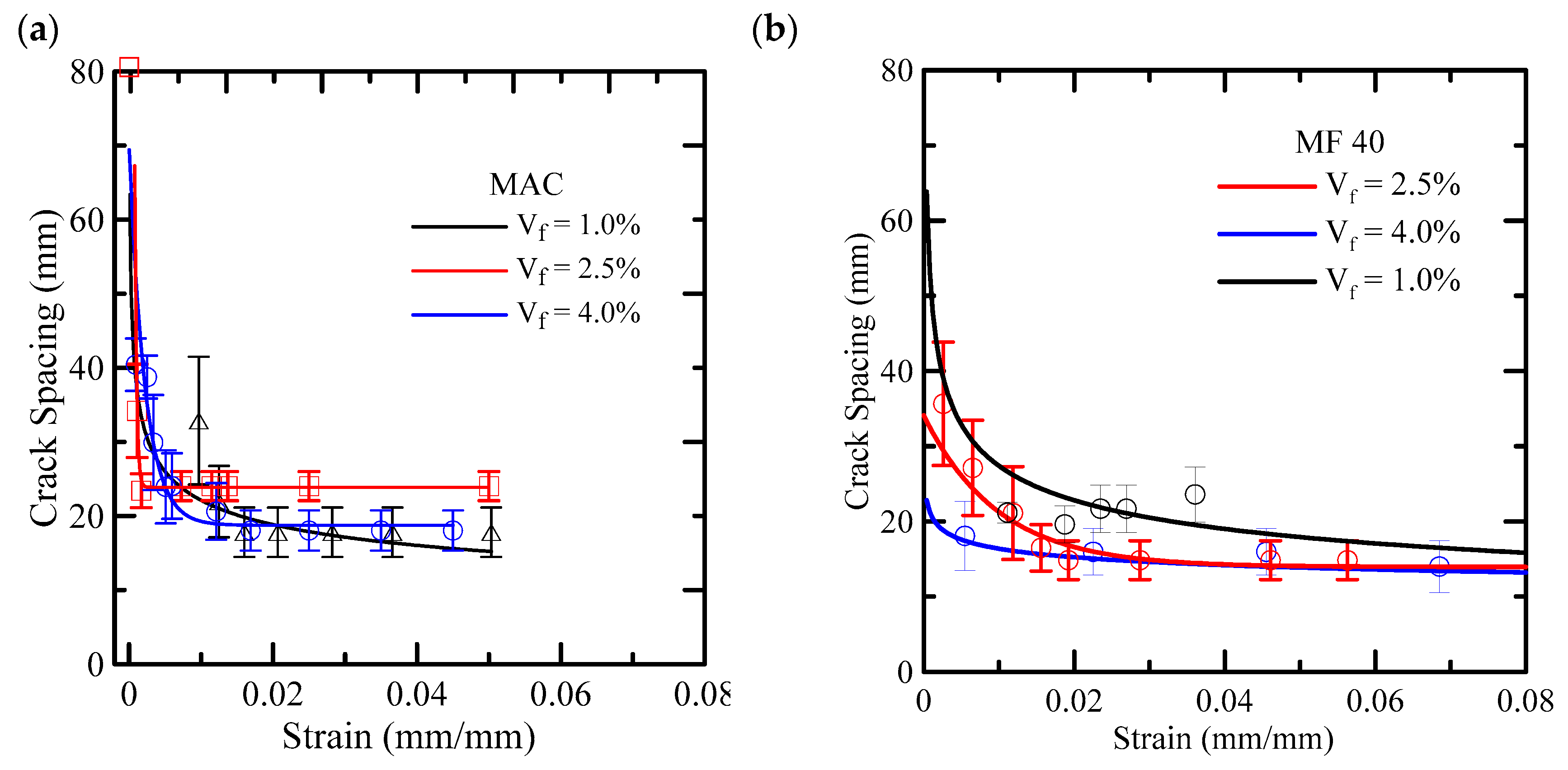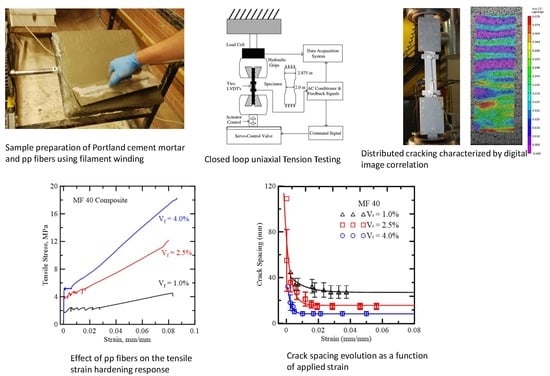3.1. Tensile Response of Fibers
Fiber tension tests were conducted under displacement control mode to measure elastic modulus, strain capacity, ultimate strength, toughness, and mode of failure. The setup is shown in
Figure 3a with a specimen under the applied load. An actuator displacement rate of 0.4 mm/min was used. Preliminary tests were conducted using fiber lengths of 150, 200, and 250 mm to address the length effect. Follow up studies used a sample length of 150 mm and a minimum of five replicate samples per series. The load was measured using a load cell rated at a capacity of 1300 N, while the elongation was recorded by an extensometer with a 50 mm gage length. A close-up view of the failed specimens with the extensometer attached is shown in
Figure 3b,c.
Stress–strain behavior for the two types of MAC and MF fiber yarns are presented in
Figure 4 and a summary of test results is given in
Table 2. The initial stress–strain curve started with a stiff response up to a stress level of about 5–7 MPa.Beyond that level, the stiffness decreased due to fiber yielding. The general behavior was linear for the monofilament samples up to the failure; however, significant nonlinearity was observed for the microfiber yarn. Gradual transition of the stress–strain response of microfiber yarns to a nonlinear behavior started from 50% ultimate strain capacity without a clearly marked yield point. Beyond this level, the stiffness reduced gradually until failure.
Table 2 summarizes the single fiber tensile test results for both fiber types representing values of initial elastic modulus, E
1, and a post yield modulus, E
2. The macro-synthetic fiber, MAC, hadcomparatively higher initial and post-yield modulus, and showed a sudden failure compared to a progressive failure of the individual filaments of MF40 yarn. The ultimate strength was reached in a gradual manner for MF40 as opposed to a sharp end for MAC.
Figure 3b,c show the failed MAC and MF40 specimens, respectively. With a strain capacity in the range of 12%, microfibers deformation was almost twice as much as the monofilament fibers, as shown in
Figure 4. Compared to MAC, the MF40 microfiber exhibited significant crazing. This response was more pronounced when the strain wasmeasured using the actuator signal, as shown in
Figure 4b, which also included the relative slipping of the individual filaments past each another, resulting in an apparent tensile strain as high as 75% for the MF series. These slip mechanisms lead to a higher strain capacity of the MF compared to MAC fibers.
The difference in strain capacity between the two fiber compositions resulted in the toughness of MF being twice that of MAC and is attributed to the structure of multifilament yarns, which by distributing the damage among multiple fibers, promoted a progressive failure mechanism. This led to a 43% higher strain capacity than the macro MAC fiber, which was an inherently stiffer system (MAC = 9.2 GPa, MF40 = 5 GPa), as shown in
Table 2. The post-yield reduced modulus for MAC was 4.6 GPa, which was 50% higher than post-yield modulus of MF40, which was at 3 GPa. Due to their strain capacity, finer MF40 fibrils required as much as 220% higher work to fracture. Multi-filament yarns uniformly distributed the load within the filaments, which failed sequentially over the failure strain range.
3.2. Tension Tests on Continuous Fiber Composites
A closed-loop servo-hydraulic test system, as shown in
Figure 5, was used in actuator displacement control mode to conduct direct tension tests on the SHCC composites. Test coupons had nominal dimensions of 300 × 62 × 13 mm. The specimen was held using hydraulic grips with the pressure maintained between 1.7 and 2 MPa. Elongation was measured along a gage length of 90 mm using two linear variable differential transformers (LVDT) of 6 mm range and their average response was recorded along with the applied load and actuator displacement.
The characteristic stress–strain, crack spacing, and crack widening responses are summarized in
Figure 6a–c. The observed stages of damage zones have been identified schematically in this figure and used in the discussion of results. The typical stress–strain response is predominantly linear up to point A, which is represented as the bend over point (BOP), this is referred to as Stage I. This is followed by the formation of the first crack in the specimen and initiation of Stage II. Between points B and C, there isthe formation of multiple distributed cracks and the initiation of fiber–matrix debonding. The bond exhibited by fibers resulted in crack bridging as the key toughening mechanism, which prevented the localization of individual cracks and promoted additional cracking. When a sufficient number of cracks had formed, stage III was initiated wherein crack saturation and widening of existing cracks occurred, leading to localized damage between points C and D. Crack saturation occurred due to limitations of the bond when stress in the matrix was insufficient to cause further cracks. Finally, in stage IV, tensile failure, fiber debonding, and slip occurred, and they were irreversible [
7]. Beyond point D, the specimen significantly lost its load-carrying capacity and ultimately underwent complete failure.The experiments addressed the composite performance of the laminates using the correlation between the fiber–matrix bond, multiple cracking, crack widening, and crack saturation density.
Figure 7 shows the tensile response of the MF 40 fiber composite at two different fiber contents of 1% and 2.5% for curing durations of 7 and 28 days. The stress–strain response can be classified using the four stages as defined in
Figure 6. In stage I, due to the linear behavior of matrix and fiber layers, the average strain in the longitudinal direction was uniform for the composite, fiber, and matrix. An increasing load initiated matrix cracking and stress was transferred to the fiber. Depending on the fiber content and bond, the first cracking was initiated in the form of a micro-crack and propagated along the width of the specimen at the bend over point (BOP) stress level, which is associated with the tensile strength of the matrix.
Figure 7 indicates that BOP was directly correlated to the fiber content and curing age, and characterized by the elastic modulus, first crack strength, and strain.
After initiation, a micro-crack may propagate in a stable manner due to fiber bridging, leading to a gradual reduction of matrix stiffness. The overall aspect of fiber contents is addressed in
Figure 8a,b. The tensile stress–strain response of MAC and MF40 composites with a control matrix at various fiber dosages are presented at distinct stages of cracking for replicate test coupons. Higher fiber content increased the first crack strength [
15] since a higher energy demand for the matrix crack propagation is imposed, which increased the apparent first crack strength. Formation of multiple parallel cracks was designated as stage II, as shown in
Figure 6a. The dominant strain hardening behavior initiated after the first crack with additional parallel cracks occurring sequentially since the stiffness of the fiber phase allows for it to carry the load released by the matrix failure. The parallel cracks formed until the minimum crack spacing was reached, which correlated with the overall stiffness of the fibers, as shown in
Figure 8c,d. The crack width and spacing were affected by the bond parameters and fiber content. This stage ended with fiber debonding as new crack formation seized and the existing cracks widened, matrix stress reduced, and fibers began to either get pulled out from the matrix or underwent fracture. In samples with 2.5% fiber, a 20% increase in BOP stress, and 35% increase in ultimate strain, which led to a 30% increase in UTS and 75% increase in toughness from 7 to 28 days of curing, was observed.
Summary results are presented in
Table 3. The effect of fiber content on the first crack strength was more pronounced for MF40 composites in comparison to the MAC fibers. This was because of the bond surface area and distribution of thefibers throughout the matrix reducing the fiber to fiber specific spacing and reducing the minimum flaw size. The fiber bridging effect on the growing cracks was enhanced due to their distribution. The switch over from Stage I to II depended on the dosage of fibers available for bridging. The first cracking stress was higher for laminates with a higher fiber volume fraction for both MAC and MF40. At the same time for each category, the increasing volume fraction increasedthe first crack strength. MAC fibers showed an average 1.4 MPa stress level for 1% and 2.5% fiber dosages, while at 4% dosage, the stress at first crack increasedto 2.6 MPa. The MF40 fibers, on the other hand, had a lower first cracking stress of 2 MPa for 1% fiber dosage and an average of 3.8MPa and 4.4 MPa for the 2.5% and 4% replicates, as shown in
Table 3. Regardless of the fibers used, stiffness, strength, and ductility increased significantly as the dosages increased. With increase in fiber content from 1%, 2.5%, and 4%; the pre-crack stiffness increased from 14.3 ± 7.4, to 21 ± 3.3, and 24 ± 14 GPa, respectively. The post-crack stiffness changes with the increase in the fiber content from 35 ± 9, 62 ± 32, to 177 ± 28 MPa for the MF fiber, which is much lower than the initial stiffness however much extends for a much larger strain range. The post-crack stiffnesses were significantly different in the two fiber systems, as shown by the reported values in
Table 3. The crack spacing of composites at the crack saturation stage is shown in
Figure 8c,d and point to the efficiency of the MF system.
The strain capacity of both macro- and micro-fiber systems, even at a 1% dosage level, exceeded 5%, which is an impressive level of deformation with significant energy absorption. The ultimate tensile strength for MAC composite replicates varied from 7.45 to 13.2 MPa. This tensile strength was significantly high and appropriate for the structural application of PP-based cementitious composites. Post-cracking stiffness increasedfrom 81 to 197 MPa over the entire strain range and depended on the various fiber contents. The overall toughness increasedfrom 0.79–0.83 MPa. MAC fibers at 1% and 2.5% fiber dosage showed similar stress–strain behavior, whereas at 4%, the overall composite stiffness and mechanical properties showed significant improvement. In all these systems, distributed cracking was the dominant mechanism, resulting in an increased overall toughness that was primarily due to a large strain range. The post-cracking behavior of the MF fibers were much improved compared to the MAC fibers, showing a stiffer post-crack response with distinct distributed cracking for 1% and 2.5% fiber dosages. However, for 4% MF40 dosage, several fine cracks close to each other resulted in a high crack density and toughness, as evident in
Figure 8d. The first cracking stress for 2.5% and 4% fiber dosage of MF40 specimens were within 3.8 to 4.4 MPa;ultimate stress was 12.5 to 17.5 MPa; and toughness was 1.1 MPa to 1.37 MPa, which was 65% higher than MAC fibers at 4% dosage. The comprehensive result in these discussions can be found in
Table 3.
3.3. Digital Image Correlation
Digital image correlation (DIC) is a full-field displacement measuring approach that tracks the physical points of a speckle pattern on the surface of a specimen under deformation. Developed by Sutton et al. [
20] and Bruck et al. [
21], it is widely applied to experimental stress analysis [
22,
23,
24]. For each subset region of a sample, the corresponding deformed position is found by searching in the vicinity that renders the correlation coefficient with the maximum likelihood or minimum cross-correlation function [
23,
24]. Commercial software VIC 3D-7 was used for measurement of crack density, spacing, and damage evolution [
4,
21,
25,
26].
Formation of a network of cracks and local strain fields are shown in
Figure 9 and
Figure 10. The relative displacements of two points, as well as crack width and spacing parametersmeasured using the DIC, was compared with the LVDTs in
Figure 9a,b. The DIC absolute and relative displacements along two horizontal segments were obtained at 10 s intervals and compared with the mean LVDT responses. The correlationwas close, as shown in
Figure 9b, which validates the non-contacting DIC method since it provides a full-range response.
The width of each crack was tracked from initiation to development to saturation stages and represented in
Figure 10 showing the sequential formation of nine distributed cracks propagating throughout the width and observed as a function of time of a representative specimen. This data was post-processed to generate the crack width and spacing response up to the failure, as shown in
Figure 10a,b representing the contour of longitudinal V displacement versus Y location for a MAC 4% (replicate 1) when all the cracks were formed. Each crack was marked as a discontinuity in displacement field, V(x), along with the Y location of the sample. The displacement discontinuity was measured as the crack width, as shown, and the crack spacing was marked as the distance along coordinate Y between any two cracks, as shown in
Figure 10c.
Experimental stress versus time was compared with the crack formation, propagation, and widening, as shown in
Figure 11a, using the individual crack openings measured using DIC post-processing. Results indicated that not all cracks were active at any given time during the loading history and the definition of strain may be significantly dependent on the gage length and the specific region of the specimen. Note that some of the cracks formed and then remained dormant before they opened further during subsequent loading stages.
As shown in
Figure 11a, Cracks 1, 5, and 3 developed early on within the first 100secs. of the test and widened within the time range of 250 to 400 secs. toreach a maximum 0.4 mm opening at the ultimate strength. However, Cracks 6 and 9 openedwhile the sample had reached its maximum stress capacity and the remaining cracks developed at a saturation crack width. The development of new cracks when the sample approachedmaximum stress indicates that multiple cracking stages of the overall composite was ending and the sample response was approaching the saturation stage. After the saturation stage, the majority of the cracks opened uniformly, indicating that the fiber phase was the primary load-carrying component. A stable crack spacing at this point and increased strains resulted in crack widening during the last stage offailure by fiber pullout. The crack spacing was measured as the distance between two cracks, as marked on the contour. At every strain, the number of cracks and their individual spacing was measured. The measure crack was plotted as function of applied strain and compared to tensile stress in
Figure 11b. The mean crack spacing from these values indicatedthe damage induced at that point. An increasing strain reducedthe average crack spacing up to the saturation point.
Figure 11b shows a saturation crack spacing of 20 mm at 0.015 strain. These data were further processed and shown as the relationship between crack spacing and applied strain.
3.4. Correlation of Fiber Size and Type on Crack Width and Spacing
The correlation of the representative stress–strain response with the distributed cracking on the two continuous fiber composites is shown in
Figure 12. The filament structure of MF fibers developed the bond with the cementitious matrix. The interstitial spaces between the multiple filaments were used for penetration of the matrix phase, resulting in a superior mechanical bond and anchorage. The tensile strength exceeded 10 MPa, which was much higher than the mono-filament MAC fibers, which shows limited improvement in performance. A summary of the results of all the MAC and MF at different fiber contents are shown in
Figure 13a,b, showing the correlation between the fiber content and crack saturation spacing measured from representative tests. With a tensile strength of about 8 MPa, the first cracking strength of MAC composites was quite similar to the plain matrix. The crack spacing–strain response implies that there were denser cracks with smaller individual crack spacing and lower saturated cracking MF fibers as compared to MAC fibers.
The intensity of crack formation increased at higher dosages. The saturation crack spacing reduced from 25 to 15 mm with increasing fiber content, as shown in
Figure 13a,b. At a dosage of 1%, the crack saturation was at 3% strain, while at dosages of 2.5% and 4%, new cracks continued to develop at higher strain levels of 6–7%, suggesting localized failure with lower dosages due to fewer cracks, and a dominance of crack-widening mechanisms.
3.5. Optical Microscopy
Toughening mechanisms were also observed by means of optical microscopy. The fiber reinforcement improved the ductility through several mechanisms that includedparallel cracking, crack bridging and deflection, fiber pullout, and fracture. The failure at the fiber–matrix interface was due to the transfer of shear stresses between the two phases, which exceeded the interfacial shear strength.
The micrographs of multiple cracking are shown in
Figure 14a–c for a representative MAC 4% specimen. Crack bridging is a key toughening mechanism within continuous fiber composites, which is shown along the width and thickness in
Figure 14c. The fibers prevent significant strains and relaxation of the composite by bridging the distributed cracks and thereby slowing crack propagation, which allows for higher toughness.
Figure 14d shows the delamination and pullout of MF40 fibers along with the transverse cracking with respect to the fiber direction. The superior bond exhibited by MF40 ledto fiber fractures accompanied by pullout.
Figure 14e shows the crack bridging provided by MF40 fibrillated fibers, which began to buckle due to unloading as the matrix unloadedand compressedthe fibers. Fiber pullout was irreversible, and the final stage of tensile failurewas associated with unloading of the cracks and buckling of bridging fibers.
